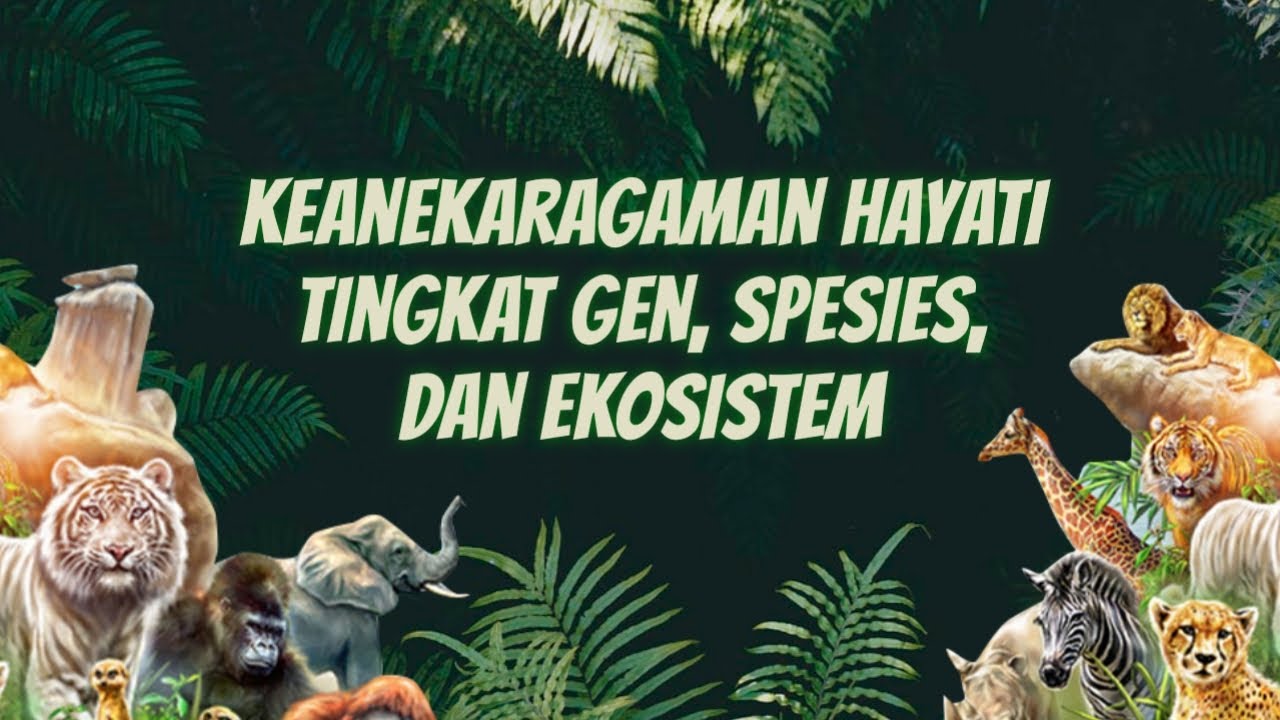Mengenal Tingkat Keanekaragaman Hayati I Biologi Kelas 10 - KHATULISTIWA MENGAJAR
Summary
TLDRThis video explores the rich diversity of living creatures on Earth, focusing on biodiversity at different levels—genetic, species, and ecosystem. It delves into examples such as the varying colors of roses in a garden, livestock diversity on a farm, and the differences between land and aquatic ecosystems. The video emphasizes the importance of understanding these levels of biodiversity, which are influenced by genetic and environmental factors, and encourages the millennial generation to actively preserve Indonesia’s diverse flora and fauna.
Takeaways
- 😀 Diversity of living creatures is influenced by both genetic and environmental factors, affecting their phenotype and gene expression, which is known as biodiversity.
- 😀 Biodiversity exists on three levels: genetic, species, and ecosystem.
- 😀 Genetic biodiversity refers to variations within the same species, such as the different colors of roses in a garden.
- 😀 Species-level biodiversity occurs when different species belong to the same genus or family, as seen in livestock like cows, horses, and goats.
- 😀 Ecosystem biodiversity results from geographical differences, affecting climate, rainfall, temperature, and ecosystem composition.
- 😀 There are different types of ecosystems, including land (e.g., savannah, grasslands, deserts) and aquatic (e.g., freshwater and marine ecosystems).
- 😀 Savannas are dominated by grass with few trees, while grasslands have no trees at all.
- 😀 Deserts and tundras have extreme climates, supporting only a limited number of organisms.
- 😀 Aquatic ecosystems are divided into freshwater and marine ecosystems, with organisms categorized into groups like plankton, nekton, and benthos.
- 😀 Indonesia is rich in biodiversity, with a wide range of flora and fauna, making its preservation a vital task for future generations.
Q & A
What is the main cause of the diversity of living creatures on Earth?
-The diversity of living creatures is influenced by genetic factors and environmental factors that affect gene expression or phenotype, a concept known as biodiversity.
How many levels of biodiversity are there, and what are they?
-There are three levels of biodiversity: genetic level, species level, and ecosystem level.
Can you give an example of biodiversity at the gene level?
-An example of biodiversity at the gene level is the variation in color among roses in a backyard garden, such as red, pink, white, and yellow roses.
What is biodiversity at the species level?
-Biodiversity at the species level refers to the diversity of different species within the same genus or family, such as cows, horses, buffaloes, goats, and chickens that are in the same family despite their different habitats and behaviors.
What factors influence biodiversity at the ecosystem level?
-Biodiversity at the ecosystem level is influenced by differences in geographical location, climate factors such as rainfall, light intensity, temperature, and the duration of exposure to the ecosystem.
What are some examples of different ecosystems mentioned in the script?
-Examples of different ecosystems include Savannah, grasslands, deserts, deciduous forests, taiga, tundra, freshwater ecosystems like swamps and rivers, and marine ecosystems like sandy beaches, coral reefs, and deep seas.
How does the environment influence the types of flora and fauna found in different ecosystems?
-The environment, including factors like temperature, rainfall, and light intensity, plays a significant role in determining the types of flora and fauna that can survive in an ecosystem. For example, only a few organisms can survive in the extreme temperatures of deserts.
What is unique about the tundra ecosystem?
-The tundra is the opposite of deserts, characterized by extreme cold, and it is home to very few organisms, similar to the conditions in the Antarctic continent.
What are the five large groups of biotic components in aquatic ecosystems?
-The five large groups of biotic components in aquatic ecosystems are plankton, nekton, benthos, ston, and periviton.
Why is Indonesia's biodiversity significant?
-Indonesia's biodiversity is significant because the country is home to a very rich variety of flora and fauna, making it one of the most biodiverse countries in the world.
Outlines

This section is available to paid users only. Please upgrade to access this part.
Upgrade NowMindmap

This section is available to paid users only. Please upgrade to access this part.
Upgrade NowKeywords

This section is available to paid users only. Please upgrade to access this part.
Upgrade NowHighlights

This section is available to paid users only. Please upgrade to access this part.
Upgrade NowTranscripts

This section is available to paid users only. Please upgrade to access this part.
Upgrade NowBrowse More Related Video

UAS PLH KEANEKARAGAMAN HAYATI - ARSYA DWI GUSTAMI - 210210201082

Keanekaragaman Hayati Tingkat Gen, Spesies, dan Ekosistem | Dunia Biologi

Tingkat Keanekaragaman Hayati | Biologi Kelas X

IPA Kelas 10 - Keanekaragaman Hayati | GIA Academy

Keanekaragaman Hayati | Belajar online mapel biologi

Video Ep 2 Persiapan SAS Biodiversity Grade 10
5.0 / 5 (0 votes)